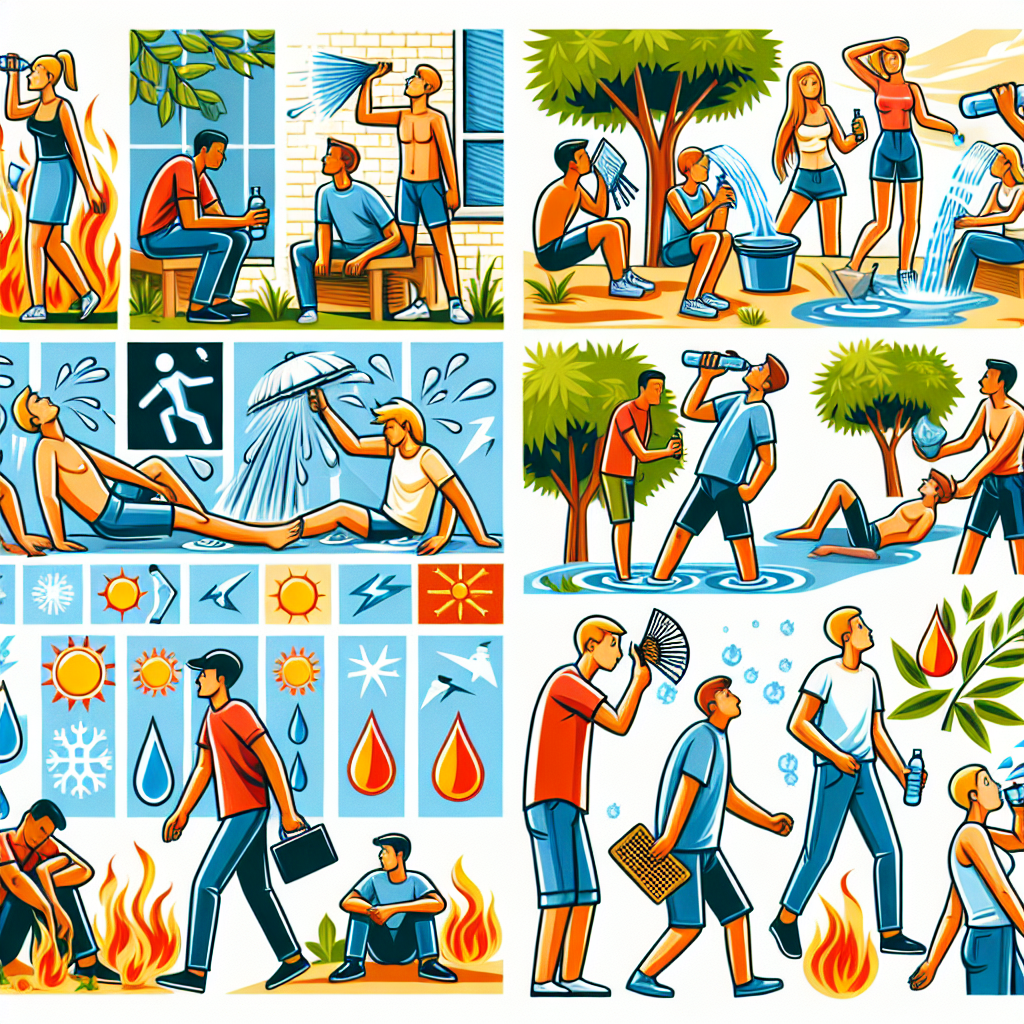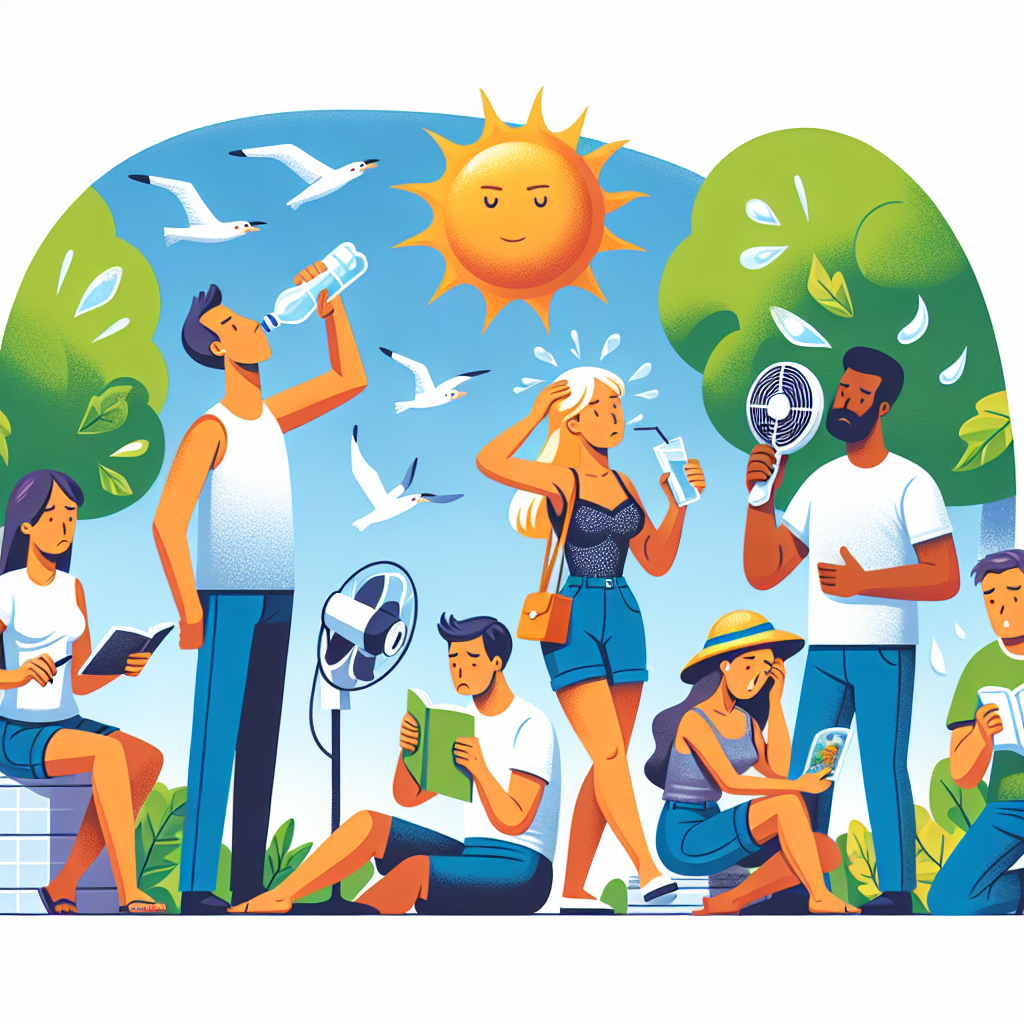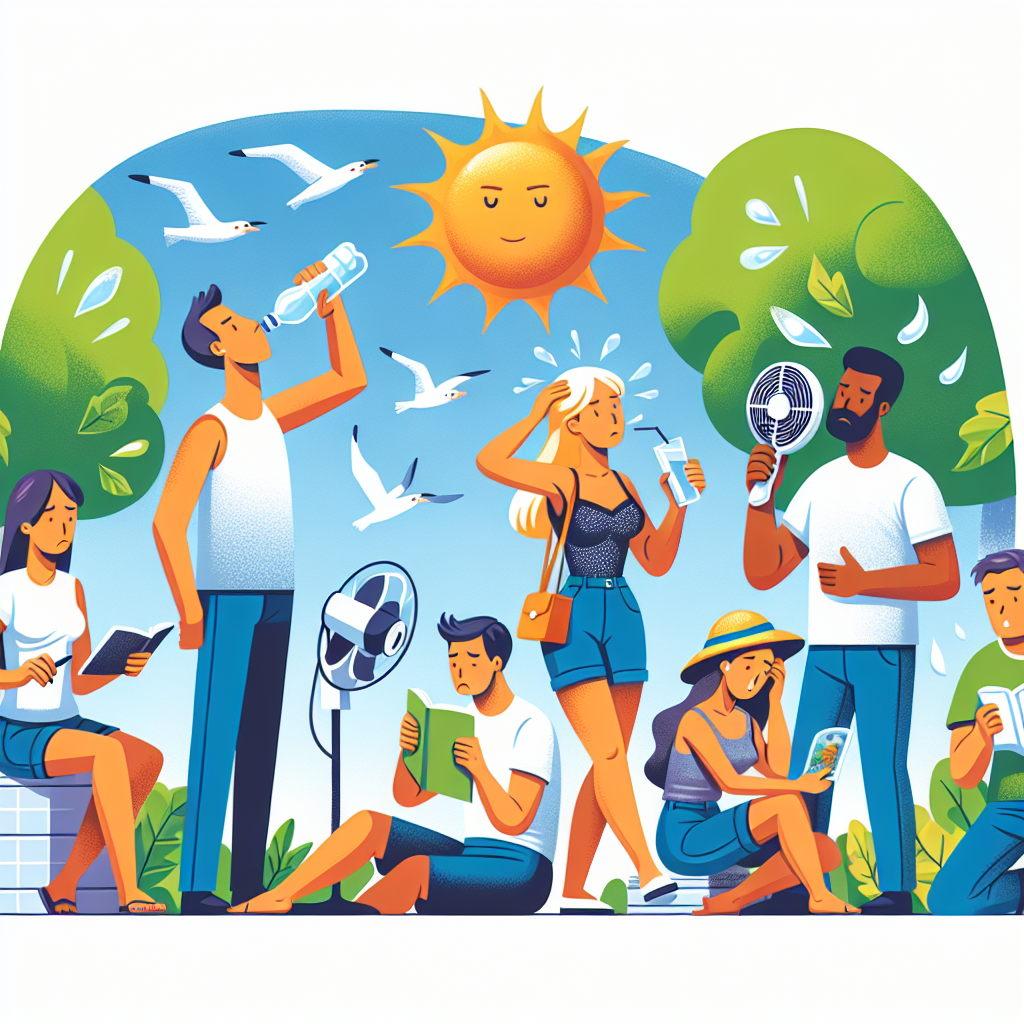Are you prepared to tackle the scorching temperatures of extreme heat? In this article, we will explore effective strategies to help you survive and thrive during intense heatwaves. We will provide valuable insights on staying cool, staying hydrated, and identifying warning signs of heat-related illnesses. So grab a cold drink, sit back, and let us equip you with the tools you need to conquer the heat and embrace the summer sun.

Understanding Extreme Heat
Definition of extreme heat
Extreme heat refers to unusually high temperatures that can pose a threat to human health and well-being. It typically occurs during heatwaves when temperatures rise significantly above the average for a particular region. Extreme heat can vary depending on the climate and geographical location, but it is generally characterized by prolonged periods of hot weather with high humidity levels.
Common causes of extreme heat
Extreme heat can be caused by a variety of factors, including heatwaves, hot weather patterns, and urban heat islands. Heatwaves occur when a large area experiences unusually high temperatures for an extended period, often exceeding the average seasonal temperatures by a significant margin. Hot weather patterns may be the result of high-pressure systems that trap warm air in a specific region. Urban heat islands, on the other hand, occur in densely populated areas where buildings, concrete, and asphalt absorb and retain heat, creating higher temperatures than in surrounding rural areas.
The dangers of extreme heat
Extreme heat poses various risks to human health and can lead to heat-related illnesses and even fatalities. Prolonged exposure to high temperatures can cause heat exhaustion, characterized by symptoms such as heavy sweating, weakness, dizziness, nausea, and confusion. If left untreated, heat exhaustion can progress to heatstroke, a life-threatening condition that requires immediate medical attention. Additionally, extreme heat can exacerbate existing health conditions, such as respiratory problems and cardiovascular diseases, and increase the risk of dehydration and heat-related injuries.
Preparing for Extreme Heat
Staying informed about heatwaves
To effectively prepare for extreme heat, it is essential to stay informed about heatwaves and weather forecasts. Pay attention to local news and weather services for regular updates on heat advisories, warnings, and watches. These alerts will provide critical information about the duration, intensity, and expected impacts of the upcoming heatwave. Familiarize yourself with the specific heat safety terminology used by local authorities to understand the severity of the situation and take appropriate measures.
Creating a heat emergency plan
Developing a heat emergency plan is crucial to ensure your safety and well-being during extreme heat events. Start by identifying cool places where you can seek refuge, such as air-conditioned buildings, shopping malls, or community centers. Determine how you will get to these locations if necessary, considering transportation options and potential road closures during heatwaves. Additionally, establish a communication plan with family members, friends, or neighbors to keep each other informed about your well-being and any assistance that may be required.
Stocking up on supplies
Stocking up on essential supplies before extreme heat hits can help you stay comfortable and safe. Ensure you have an ample supply of clean drinking water to stay hydrated, as well as non-perishable food items that do not require cooking. Keep a first aid kit handy, stocked with necessary medications and supplies. It is also advisable to have battery-powered fans, flashlights, and extra batteries in case of power outages. Don’t forget to have a supply of sunscreen, sunglasses, and hats to protect yourself from the sun’s harmful rays.
Staying Safe Indoors
Using air conditioning effectively
Air conditioning is an effective way to stay cool and comfortable indoors during extreme heat. Ensure your air conditioning system is in good working condition before heatwaves strike. Set the thermostat to a comfortable temperature and avoid constantly adjusting it, as this can strain the system. If you don’t have access to air conditioning, consider visiting public spaces with air conditioning, such as libraries, shopping malls, or movie theaters, to escape the heat during the hottest parts of the day.
Ventilating your home
Proper ventilation can improve indoor air circulation and help alleviate the effects of extreme heat. During cooler hours, open windows and doors to allow fresh air to flow through your home. Use fans strategically to create a cross-breeze, pulling in cool air from one side and expelling warm air from the other. Utilize window coverings, such as blinds or curtains, to block out direct sunlight, reducing heat gain indoors. When using fans, remember that they only circulate air; they do not cool the room, so it’s essential to consider the heat index when relying on fans alone.
Keeping hydrated indoors
Staying hydrated is crucial during extreme heat to prevent dehydration. Drink plenty of water even if you don’t feel thirsty, as your body may not signal thirst until you’re already dehydrated. Avoid sugary drinks and caffeinated beverages as they can contribute to dehydration. Consider adding electrolyte-rich drinks or sports drinks to replenish essential minerals lost through sweating. Keep a water bottle nearby and take regular sips throughout the day. If you’re not a fan of plain water, try infusing it with refreshing flavors like citrus or cucumber.
Staying Safe Outdoors
Choosing the right clothing
Wearing appropriate clothing is essential to protect yourself from the sun and minimize heat absorption. Opt for lightweight, loose-fitting, and light-colored clothing made from breathable fabrics such as cotton or linen. These materials allow air to circulate and sweat to evaporate, helping to keep your body cool. Avoid dark-colored clothing as it absorbs more heat from the sun. Don’t forget to wear a wide-brimmed hat, sunglasses, and use sunscreen with a high SPF to shield your face and exposed skin from harmful ultraviolet (UV) rays.
Protecting your skin from sunburn
When spending time outdoors during extreme heat, it is crucial to protect your skin from sunburn and UV damage. Apply a broad-spectrum sunscreen with an SPF of at least 30 to all exposed areas of skin, including the face, neck, arms, and legs. Reapply sunscreen every two hours or more frequently if you sweat heavily or engage in water activities. Seek shade during the sun’s peak hours, typically from 10 am to 4 pm, to minimize direct sun exposure. Remember, even on cloudy days, UV rays can still penetrate through the clouds and cause skin damage.
Finding shade and creating shade structures
Seeking out shade whenever possible can significantly help reduce the risk of heat-related illnesses. When spending time outdoors, look for natural sources of shade, such as trees, umbrellas, or canopies. If shade is limited or unavailable, consider creating your temporary shade structures. Portable shade tents or beach umbrellas can provide instant relief from the sun’s scorching rays. Position them strategically to block direct sunlight and create a shaded area where you can take breaks and cool down.

Managing Your Body Temperature
Drinking plenty of water
One of the most critical aspects of managing extreme heat is maintaining proper hydration. Drink plenty of water throughout the day, even if you don’t feel thirsty. Aim to consume at least eight glasses (64 ounces) of water or more, depending on your activity level and sweat loss. Avoid drinking excessively cold water, as it can cause stomach discomfort or cramps. If you engage in physical activities or spend prolonged periods outdoors, consider carrying a reusable water bottle and take regular sips to stay hydrated.
Avoiding alcoholic beverages
While it may be tempting to reach for a refreshing alcoholic beverage during hot weather, it’s best to avoid them during extreme heat. Alcohol acts as a diuretic, increasing urine production and potentially leading to dehydration. It can also impair your judgment and make you more susceptible to heatstroke or other heat-related illnesses. If you choose to consume alcoholic beverages, do so in moderation and balance it with ample water intake to stay properly hydrated.
Using cooling methods such as wet towels or fans
Implementing cooling methods can help regulate your body temperature and provide relief from extreme heat. Wet towels or bandanas and place them around your neck, on your forehead, or wrists. As the water evaporates, it creates a cooling effect on your skin. Utilize fans or handheld misting fans to create airflow and evaporate sweat faster. You can also place a bowl of ice or a frozen water bottle in front of a fan to circulate cooler air around the room. These simple cooling methods can make a significant difference in your comfort level during intense heat.
Eating and Drinking for Maximum Resilience
Eating light and nutritious meals
During extreme heat, it’s essential to adjust your diet to include light and nutrient-rich meals that are easier to digest. Include plenty of fruits and vegetables in your diet, as they are hydrating and provide essential vitamins and minerals. Opt for smaller, more frequent meals, rather than heavy, large meals that can strain your digestive system. Consider incorporating foods with high water content, such as cucumbers, watermelon, or leafy greens, into your diet to maintain hydration and support overall well-being.
Avoiding heavy and greasy foods
Heavy and greasy foods can make you feel sluggish and increase body heat production during extreme heat. Avoid foods that are high in fat, fried, or heavily processed, as they can be harder to digest and may leave you feeling bloated or uncomfortable. These foods can also increase the risk of indigestion or heartburn, which can be particularly unpleasant in hot weather. Opt for lighter options such as grilled lean meats, salads, and fresh produce that provide essential nutrients while being gentler on your digestive system.
Choosing hydrating beverages
In addition to drinking plenty of water, incorporating hydrating beverages into your routine can help replenish electrolytes lost through sweat and keep you refreshed. Coconut water is a natural electrolyte-rich beverage that can provide hydration while adding a touch of sweetness. Herbal teas, such as mint or chamomile, can be enjoyed hot or iced to offer a refreshing alternative to sugary or caffeinated drinks. If you prefer flavored beverages, be cautious of sugary drinks and opt for sugar-free or naturally sweetened options.
Taking Care of Vulnerable Populations
Ensuring the safety of children and the elderly
During extreme heat, it is vital to pay extra attention to the well-being of children and the elderly, who are more vulnerable to heat-related illnesses. Ensure they have access to cool, well-ventilated spaces and stay hydrated throughout the day. Dress children and the elderly in lightweight, breathable clothing and protect their skin with sunscreen and protective clothing. Never leave children, the elderly, or pets unattended in vehicles, as the temperature inside a car can rise to dangerous levels within minutes.
Providing access to cooling centers
Creating access to cooling centers can be a lifesaver for those without proper cooling facilities at home. Consider supporting or advocating for the establishment of cooling centers in your community, particularly in areas with a large concentration of vulnerable populations. Cooling centers provide a safe and air-conditioned environment where individuals can seek temporary relief from extreme heat. They are often set up in community centers, libraries, or municipal buildings and offer water, seating, and other resources to help individuals escape the heat.
Checking on neighbors and friends
During extreme heat, it is crucial to look out for one another and check on neighbors, friends, and family members, especially those who are elderly, living alone, or have health conditions. Make a point to visit or call them regularly to ensure they are coping with the heat. Offer assistance with tasks that require going outdoors, such as grocery shopping or running errands. If someone is unresponsive or shows signs of heat-related illness, call emergency services immediately.
Recognizing and Responding to Heat-related Illnesses
Identifying heat exhaustion symptoms
Recognizing the symptoms of heat exhaustion is vital for early intervention and prevention of more severe heat-related illnesses. Some common signs of heat exhaustion include heavy sweating, weakness or fatigue, dizziness or lightheadedness, headache, nausea or vomiting, muscle cramps, and fainting. If you or someone around you experiences these symptoms, it is crucial to take immediate action to prevent further complications.
Responding to heat exhaustion
If you or someone you know is experiencing heat exhaustion, it is essential to take prompt action to prevent the condition from worsening. Move to a cool, shaded area or an air-conditioned space as soon as possible. Help the person affected to lie down, elevate their legs slightly, and loosen tight or restrictive clothing. Provide cool water to drink in small sips and use wet towels or misting fans to cool the body. If symptoms do not improve or worsen, or if the person loses consciousness, call emergency services immediately.
Recognizing heatstroke symptoms and providing first aid
Heatstroke is a life-threatening condition that requires immediate medical attention. Symptoms of heatstroke include a high body temperature (above 103°F or 39.4°C), hot and dry skin (lack of sweating), rapid heartbeat, confusion or disorientation, throbbing headache, nausea or vomiting, seizures, and unconsciousness. If you suspect someone is experiencing heatstroke, call emergency services right away. While waiting for medical help to arrive, move the person to a shaded area, remove excess clothing, and cool their body using whatever means are available, such as wet towels or fanning.
Tips for Sleeping Comfortably
Creating a cool sleeping environment
Getting a good night’s sleep during extreme heat can be challenging but crucial for your well-being. Create a cool sleeping environment by closing curtains or shades during the day to block out heat. Open windows and use fans or air conditioning to circulate air before bedtime. Consider using a bed fan or cooling mattress pad to maintain a cooler temperature throughout the night. If possible, relocate to a lower floor or the basement, as heat tends to rise, making upper levels warmer.
Using breathable bedding materials
Choosing the right bedding materials can help promote better airflow and regulate body temperature while sleeping. Opt for breathable fabrics such as cotton or bamboo for sheets, pillowcases, and blankets. These materials allow air to circulate and wick away moisture, keeping you cool and comfortable. Avoid synthetic materials like polyester, as they tend to trap heat and retain moisture, making you feel hot and sweaty during the night. Additionally, using a light, breathable comforter or switching to a lighter-weight duvet insert can prevent excessive heat retention.
Taking cool showers before bedtime
Taking a cool shower before bed can help lower your body temperature and promote better sleep. The refreshing sensation of cool water can provide immediate relief from the heat, helping you relax and unwind before bedtime. Keep the shower short and avoid using hot water, as it can increase your body temperature. After showering, pat your skin dry instead of rubbing vigorously to retain some moisture, which can have a cooling effect as it evaporates. Enjoying a cool shower is a simple and effective way to prepare your body for a more comfortable night’s sleep.
Maintaining Personal Hygiene
Keeping clean and fresh in extreme heat
Maintaining personal hygiene is essential even in extreme heat, as it helps prevent skin irritations and infections. Shower or bathe regularly to cleanse your body of sweat and bacteria, focusing on areas prone to perspiration, such as underarms, groin, and feet. Use mild soap and lukewarm water to avoid drying out your skin. After bathing, ensure you dry thoroughly to minimize the risk of fungal or bacterial growth in moist areas. Remember to change your clothes regularly, opt for breathable fabrics, and wear clean, moisture-wicking socks to keep your skin clean and fresh.
Using alternative bathing methods if necessary
In situations where access to running water or bathing facilities is limited, it’s essential to adapt and utilize alternative bathing methods. Wet wipes or pre-moistened cloths can provide a quick and convenient way to freshen up when traditional bathing is not possible. Look for wipes specifically designed for personal hygiene, particularly ones labeled as alcohol-free and hypoallergenic. Pay attention to hygiene practices for sensitive areas, such as the underarms and groin, to prevent discomfort or skin irritations. Additionally, dry shampoo or talcum powder can be used to absorb excess oil and maintain scalp hygiene between washes.
Practicing good oral hygiene
Oral hygiene should not be overlooked, even in extreme heat. Brush your teeth at least twice a day using a soft-bristled toothbrush and fluoride toothpaste. If possible, rinse your mouth with a refreshing mouthwash to help combat dry mouth and refresh your breath. Stay vigilant about flossing daily to remove food particles and plaque buildup between your teeth. If brushing is not feasible, consider using pre-packaged disposable toothbrushes with toothpaste or sugar-free chewing gum to promote saliva production and maintain oral hygiene on the go.

